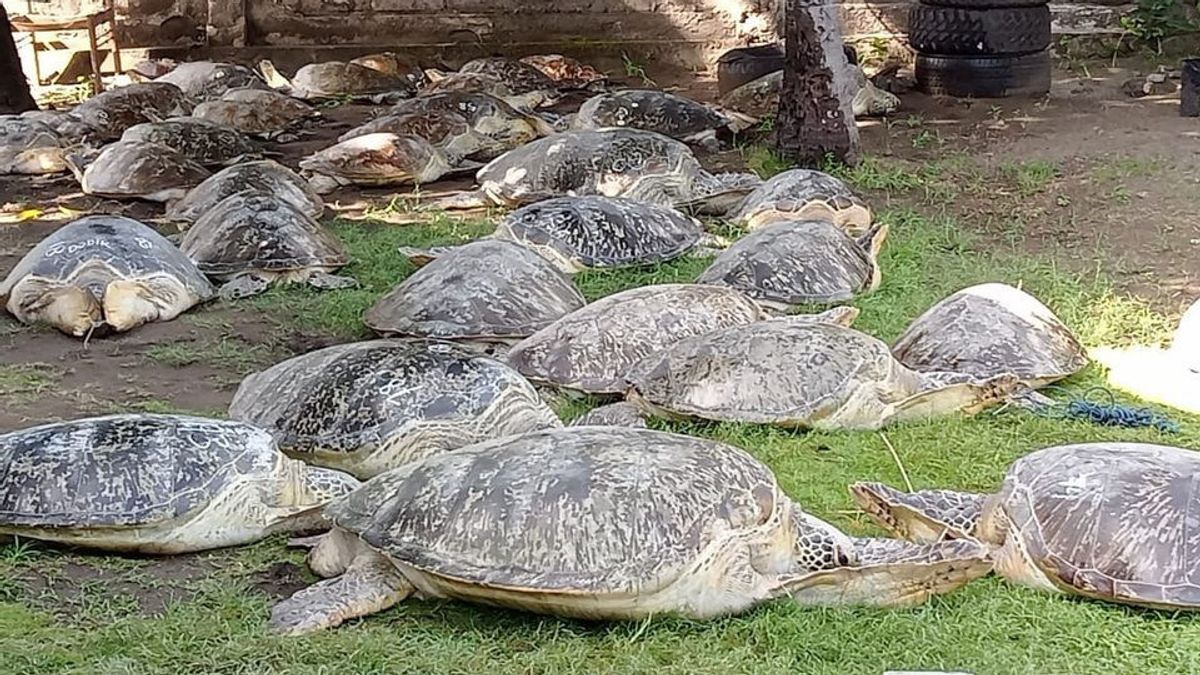JAKARTA The province of Bali is still the main goal of the illegal turtle trade. A total of 43 green turtles that were secured in Klatakan Beach, Jembrana, Bali on January 13 is proof. This situation certainly makes it difficult for the turtle conservation program, one of the protected marine reptiles.
This is not the first case that has occurred in Bali. Throughout 2022 alone, it has been recorded that the authorities have several times thwarted smuggling attempts and confiscated a total of tens of turtles.
When looking at history, Bali has indeed been the center of turtle trade since the 1960s. Turtles in the mythology of Balinese Hindus are considered sacred animals that support the world, creating natural balance and harmony. Moertjipto and Bambang Prasetya in the book 'The Kresnayana Relief of the Visnu Temple' call turtles the incarnation of Lord Vishnu.
That is why, a number of traditional ceremonies in Bali have a special procession of eating turtle meat. In fact, traditional ceremonies, such as Pedudusan Agung, Ngeteg Linggih, Eka Dasa Rudra, and Panca Bali Krama, are reportedly still carrying out the ritual until now, even though it is only as a ceremony.
The head, tail, and fin of the turtle are left intact, while the meat is processed into offerings in satay, seagrass and others.
As the tourism sector in Bali continues to accelerate, turtle dishes begin to become a typical culinary delight which is also selling well for the community and tourists. That said, wrote Agus Susanto in the book 'Pemangkaran Turtle', there are dozens of restaurants that usually provide turtle meat dishes. Not to mention that on the side of the road.
In fact, souvenirs originating from the turtle body were selling well. Thus, the need for turtles from year to year has increased dramatically. In the 1981-1988 period alone, Agus said, the number of turtles supplied to Bali was an average of 14 thousand heads per year.
On the other hand, this condition raises concerns from a number of environmental observer institutions. This is because the success rate of turtle life is quite low according to expert studies. It is possible that only 1-2 percent of turtles can grow to an adult age from hundreds of eggs produced.
The International Union Conservation of Nature (IUCN) reacted strongly. Making Indonesia has exploited turtles to threaten the extinction and damage of the marine ecosystem. So furious, the non-profit organization that defended the Greenpeace environment in 1989 also campaigned for Slaugther in Paradise, inviting the world community to boycott Bali tourism.
Indonesia is the largest breeding ground for scales turtles and green turtles. Unfortunately, these two species are becoming extinct. It is estimated that 21,000 green turtles have been slaughtered, and this number continues to increase," Greenpeace wrote.
Indonesia's World Wildlife Fund (WWF) also said that more than 50,000 sea turtles were killed in Southeast Asia (specifically in Bali, Indonesia) and in the South Pacific.
The Indonesian government then issued Law No. 5 of 1990 concerning Conservation of Biological Natural Resources and their Ecosystems. This law prohibits turtle trade for commercial purposes because all types of sea turtles have been included in the appendix I based on the provisions of Convention on International Trade in Endangered Species of Wild Flora and Fauna (CITES).
Then, in 1999, re-issued Government Regulation (PP) Number 7 of 1999 concerning Determination of Plant and Animal Types. This means that the government prohibits all forms of turtle trade, both alive, dead, and selling of body parts.
However, for customary purposes, the government's attitude is wiser. Bali Natural Resources Conservation Agency (BKSDA) Head Sumarsono said, "Every traditional village can make written applications to BKSDA. Turtles are taken not from nature, but turtles that we enlarge ourselves, starting from eggs. So, it is not arbitrary, we are selective, and its use is monitored."
Even though there are these rules, it turns out that turtle catching and trading are still rampant. Agus considered it very difficult to prevent it. There are many social and economic aspects of the community concerned. Moreover, if you look at the selling value.
The price of turtles in illegal markets, according to several sources, could reach IDR 5 million per head, even more for large sizes. Or some sell it at a kiloan price, up to IDR 85 thousand per kilogram.
As a solution, Agus gave several ideas of approach to seeking reduction in catching towards turtle conservation, such as:
These efforts are not easy to implement. Related aspects require coordination. These include alignment of central and regional relations. Especially for green turtles, conservation efforts are not handled only from ecological and biological aspects, but also through a humane (cultural) and economic approach," Agus Susanto wrote in the book Turtle breeding.
The English, Chinese, Japanese, Arabic, and French versions are automatically generated by the AI. So there may still be inaccuracies in translating, please always see Indonesian as our main language. (system supported by DigitalSiber.id)









